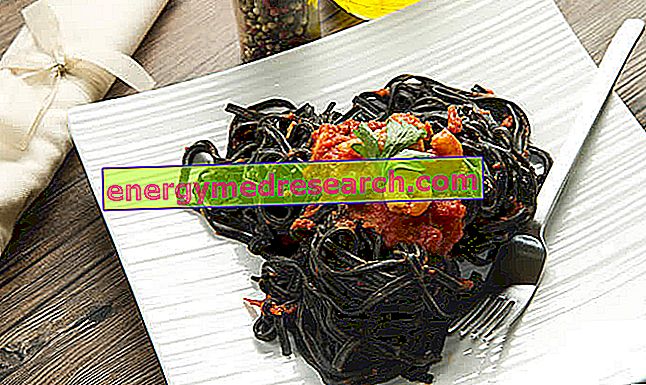Generality
What are carobs?
Carobs are the fruits of the Ceratonia siliqua tree, commonly called the carob tree.
These fruits are to all effects of legumes, since the carob is made to fall into the legume family (Fabaceae).

Carobs find application in food, both human and animal, but above all in the food industry as an additive.
The carob raw pulp has a sweetish taste, similar to cocoa.
Curiosity: did you know that the seeds of the carob are also called carats?
This name was attributed to him because of their surprising weight uniformity; each of them weighs exactly 1/5 of a gram and in ancient times they were used to weigh precious objects and valuables.
The same word "carat" comes from the Greek name of carob (see the chapter: Etymologies of the term carruba).
Botanical outline
The carob is an evergreen tree belonging to the Fabaceae family (the same as the peas, fava beans, favioli, etc.) and the genus Ceratonia (binomial nomenclature Ceratonia siliqua ).
Also known as tree-locust, the carob tree should not be confused with Parkia biglobosa or "African locust bean".
Despite the geographical origins of the plant are uncertain, it is conceivable that, even before its cultivation, it already occupied most of the European, African and Asian territory. Some argue that the carob tree was born near the Mediterranean Sea, therefore in Southern Europe, in North Africa, on the large islands, in the Levant and the Middle East, in Western Asia, but also in the Canary archipelago and in Macaronesia.

Cultivation
The carob is grown mainly in Spain, Portugal, northern Africa and in some Middle Eastern countries. In Italy plantations of carob trees embellish the environment of the coastal territories of Liguria and a little of the whole central and southern area.
Etymology of the term carob
Locust beans are also known as S. Giovanni bread or locust beans.
The etymology of the name "carrube" (or even "carube") has Arabic origins and comes from the noun "kharrūb", later adapted into Hebrew, later into Greek, Latin, French etc.
It is curious to learn that, thanks to the characteristic uniformity of its seeds, from the Greek name of the carobs (keration) derived the noun "carat" (unit of measurement for the mass of precious materials).
Purposes
What are carobs used for?
Carob seeds are used both in human nutrition (mainly as flour - carob or carob flour) and animal (forage made from whole pods).
However, beyond the purely industrial context, carob is today considered "a forgotten fruit" and as such difficult to find. Generally, it is sold together with dried fruit or typical products from central and southern Italy, sometimes with prohibitive costs. This is why, in Italy, carob trees are planted almost exclusively for ornamental purposes.
Carob in human nutrition
From the dried and ground carobs is obtained a flour used as:
- Cocoa substitute
- Food additive
- Dietary food.
Let's look at them in more detail.
Nutritional Properties
Chemical and nutritional properties of carobs
Carob flour as a substitute for cocoa and chocolate
Carob flour is vaguely reminiscent of cocoa; therefore, it is used as an ingredient in some recipes (for example for cocoa allergies) or for tablets as a chocolate substitute.

The absence of psychoactive substances, such as caffeine and theobromine, makes carobs an ideal substitute for those suffering from hypersensitivity to these substances or for those who should not take them for other reasons.
The high fiber content makes them a particularly satiating food, able to combine flavor and well-being.
When mixed with saturated fats such as those contained in butter or tropical oils, carob flour gives rise to a product that is even more similar in taste and texture to traditional chocolate.
Locust bean gum as a food additive
Carob seed flour has a binding, thickening and gelling function, and is used mainly in the confectionery and food preserves industry. This ingredient, also known as E410, has the ability to absorb water up to 50-100 times its weight. For this reason, carob flour is used as a thickener in many food preparations, including canned meats and ice creams.
See all Recipes with Carob Flour, like Nutella® ice cream that we offer in this video:
Nutella® ice cream
X Problems with video playback? Reload from YouTube Go to Video Page Go to Video Recipes Section Watch the video on youtubeCarob as a diet food - even whole, dried or fresh seeds
Thanks to their content in fibers (rubbers) and tannins (antioxidants with mild anti-nutritional function), the carobs carry out many functions:
- Anti-obesity: carobs are rich in tannins, nutritional factors generally beneficial and with an antioxidant function which, if taken in massive quantities, can reduce the activity of certain digestive enzymes. This determines a controlled malabsorption, which can promote weight reduction.
- Reduction of fat absorption: due to the enzymatic inhibition, but also thanks to the gelling of the intestinal contents, the carobs reduce the lipid absorption and above all the alimentary cholesterol and bile juices.
- Moderation of the glycemic and insulin surge: for the same principles described above, the carobs modulate the absorption of carbohydrates, reducing the glycemic and insulin surge. For this reason they lend themselves to the diet of the obese and type 2 diabetic.
- Prebiotic function: the intestinal bacterial flora feeds on various compounds present in carob seeds (especially soluble fibers and carbohydrates).
- Anti-constipation function: exercised above all by the fresh pulp of the seeds; even flours properly rehydrated and associated with large quantities of water can help soften the faeces, facilitating their expulsion.
- Anti-diarrheal function: in particular situations, thanks to this ability to absorb water, carob flour is an excellent antidiarrheal.
- Gastro-protective function: the locust beans, forming a gelatinous compound, are also used as a remedy for heartburn (gastric acidity), but do not replace drug therapy for diagnosed diseases.
In pregnancy they can reduce the problem of gravid nausea.
Side effects
Can the intake of locust beans cause side effects?
Locust beans are considered probably safe for the diet of most subjects, as long as they are taken by mouth in food quantities or as a supplement. They don't seem to have any unwanted side effects.
It is good practice to avoid excessive consumption, especially in the event of:
- Pregnancy and breastfeeding.
- Constipation, if not consumed with large amounts of water.
- Diarrhea, if consumed with large amounts of water.
- Underweight.
- Specific or generalized malnutrition.



